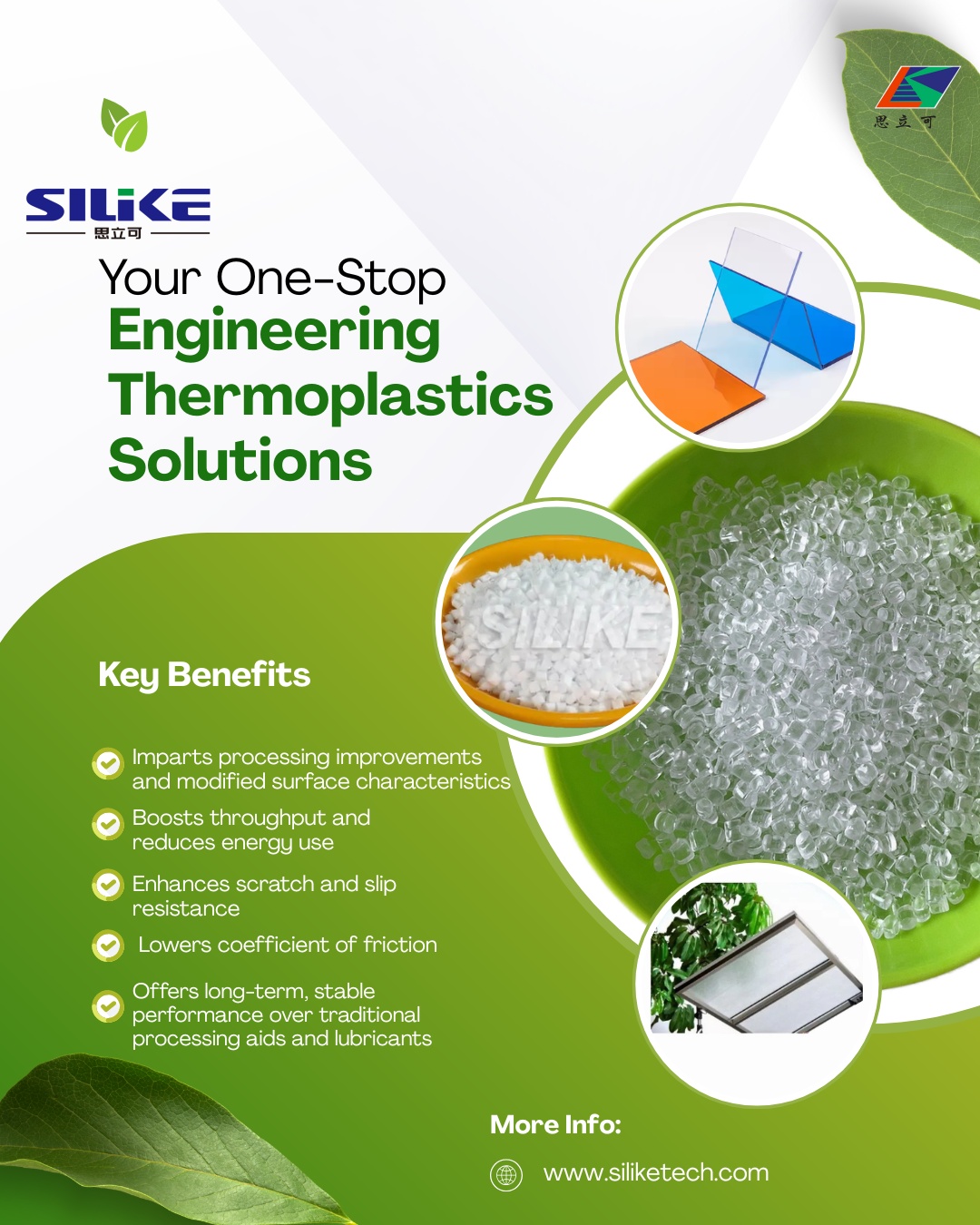Polycarbonate (PC) is one of the most versatile engineering thermoplastics used in automotive lenses, consumer electronics, eyewear, and protective gear. Its high impact strength, optical clarity, and dimensional stability make it ideal for demanding applications. However, a well-known drawback of PC is its low surface hardness, which leads to poor scratch and wear resistance—especially under frequent contact or abrasive conditions.
So, how can manufacturers enhance the surface durability of PC without compromising its transparency or mechanical properties? Let’s explore a range of effective solutions and industry-validated techniques to overcome these challenges.
Solution: Combine processing enhancements and surface property modifications with advanced protection technologies.
1. Silicone-Based Additives: Internal lubricity Incorporating high-performance silicone additives, such as polydimethylsiloxane (PDMS) or siloxane-based masterbatches like Dow MB50-001, Wacker GENIOPLAST, and SILIKE Silicone Masterbatch LYSI-413, into polycarbonate (PC) formulations can significantly enhance the material’s performance. By using these additives at a loading level of 1-3%, you can effectively reduce the coefficient of friction, which improves both scratch resistance and wear durability.
Key Benefits: These silicone additives, as PC processing additives and modifiers, not only preserve the optical clarity of PC but also boost surface lubricity. This results in a remarkable reduction in surface damage during abrasive contact, ultimately leading to improved product longevity.
Practical Tip: To ensure optimal performance, it is essential to achieve proper dispersion through twin-screw extrusion, which helps prevent phase separation and maximizes the benefits of the additives.
Introducing SILIKE Silicone-Based Additive, Strategy to Enhance Scratch and Wear Resistance of PC Engineering Plastics
Chengdu SILIKE Technology Co., Ltd is a leading Chinese supplier of silicone additives for modified plastics. The company offers innovative solutions designed to enhance the performance and functionality of various plastic materials. One of their standout products is the SILIKE Silicone Masterbatch LYSI-413, a highly effective pelletized formulation that contains 25% ultra-high molecular weight siloxane polymer dispersed in polycarbonate (PC). This silicone-based additive is particularly effective for PC-compatible resin systems. It improves processing properties and surface quality by enhancing the flowability of the resin, facilitating mold filling and release, reducing extruder torque, lowering the coefficient of friction, and providing superior mar and abrasion resistance. Additionally, this siloxane-based masterbatch functions as an anti-scratch additive, making it an excellent solution for increasing the scratch resistance of PC products and ultimately improving their overall performance and durability.

2. UV-Curable Hard Coatings with Nanotechnology
Apply advanced siloxane-based or hybrid organic-inorganic hard coatings (e.g., Momentive SilFORT AS4700 or PPG’s DuraShield). These coatings achieve pencil hardness up to 7H-9H, significantly improving scratch resistance. Incorporate UV-curable coatings with nanoparticles (e.g., silica or zirconia) to further boost abrasion resistance. Benefit: Provides a protective barrier against scratches, chemicals, and UV degradation, ideal for optical and automotive applications. Application: Use dip-coating, spray-coating, or flow-coating for uniform thickness (5-10 µm).
3. Nanocomposite Reinforcement
Add nanofillers like nanosilica, alumina, or graphene oxide (0.5-2% by weight) to the PC matrix. These increase surface hardness and improve wear resistance without significantly affecting transparency if the particle size is
4. PC Blends for Balanced Performance
Blend PC with PMMA (10-20%) to enhance surface hardness or with PBT for improved toughness and wear resistance. These blends balance scratch resistance with PC’s inherent impact strength. Example: A PC/PMMA blend with 15% PMMA can increase surface hardness while retaining clarity for display applications. Caution: Optimize blend ratios to avoid compromising PC’s thermal stability or toughness.
5. Advanced Surface Modification Techniques
Plasma Treatment: Apply plasma-enhanced chemical vapor deposition (PECVD) to deposit thin, hard coatings like silicon oxynitride (SiOxNy) on PC surfaces. This improves scratch resistance and wear properties.
Laser Texturing: Create micro- or nano-scale textures on the PC surface to reduce contact area and diffuse scratches, improving aesthetic durability. Benefit: Texturing can reduce visible scratches by up to 40% in high-contact applications.
6. Additive Combinations for Synergy
Combine silicone additives with other functional additives like PTFE (polytetrafluoroethylene) micropowders (0.5-1%) for synergistic effects. PTFE enhances lubricity, while silicone improves wear resistance. Example: A blend of 2% silicone masterbatch and 0.5% PTFE can reduce wear rates by 25% in sliding applications.
7. Optimized Processing Conditions:
Use high-shear compounding to uniformly disperse additives and fillers. Maintain PC processing temperatures (260-310°C) to avoid degradation. Employ precision molding techniques (e.g., injection molding with polished molds) to minimize surface defects that could initiate scratches. Anneal molded parts at 120-130°C to relieve internal stresses, improving long-term wear performance. Innovation Watch: Self-Healing and DLC Coatings on the Rise Emerging technologies like self-healing coatings (based on polyurethane or siloxane chemistry) and diamond-like carbon (DLC) coatings offer future-proof solutions for ultra-durable, high-touch PC applications. While still cost-prohibitive for mass-market products, these technologies show promise in luxury electronics, automotive, and aerospace.
Recommended Approach for Optimal Performance in Engineering Thermoplastics For manufacturers seeking a practical, scalable solution to improve PC surface durability, we recommend:
1) 2% UHMW Silicone Additive for internal lubricity
2) Siloxane-based UV Coating + 1% Nano Silica for surface hardness
3) Micro-Texturing via Laser Molding to hide scratches
This three-pronged approach delivers a balance of cost-efficiency, processing compatibility, and performance, making it ideal for products exposed to daily wear and requiring long-lasting aesthetics.
Industry Proven According to a 2024 report by MarketsandMarkets, the global hard coatings market is projected to exceed $1.3 billion by 2027, driven by growing demand for scratch-resistant plastics in automotive displays, mobile devices, and optical lenses. Material formulators and compounders integrating multifunctional additives and nano-fillers are well-positioned to lead the next generation of durable PC-based products.
Ready to boost your engineering plastics like PC with better scratch and wear resistance? Explore SILIKE plastics additive solutions that enhance processing and surface properties to meet your durability demands. For further information, please visit our website at www.siliketech.com, or contact us at Tel: +86-28-83625089 or via email at amy.wang@silike.cn. we provide efficient plastics processing solutions.
Media Contact
Company Name: Chengdu Silike Technology Co., Ltd.
Email: Send Email
Country: China
Website: https://www.siliketech.com/






